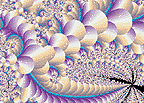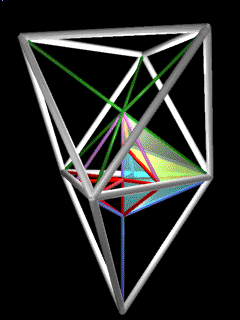

Part Seven
Now take it higher, he says.
Higher? I ask.
Advance it one dimension, he directs.
OK, what do you get??
What is your visual??My visual?
I am unsure.
I'll have to get back to you on that one . . .
The Mandelbrot Set
For People Who Don't Want to Hear About Numbers
What Are These Things?
When I show these images to friends who, like myself, have no background in math or the sciences, they invariably want to know what they are and where they came from. Herein find a sketchy, non-mathematical, fanciful, and, like most extreme simplifications, probably inaccurate answer to that question.The Mandelbrot set is the graph of a mathematical formula. It takes its name from Benoit Mandelbrot, the mathematician who first fed it into a computer and was amazed by the world he had opened. Before that no one had ever seen these patterns. This formula and others like it had been known for many years, but there was way too much calculation involved to plot them by hand.
The second question everyone asks concerns how the numbers turn into something visible on the screen.
Answer
The computer calculates a numerical value for each point on the screen and the operator assigns a color to each number, ie. all points with a value of three will be pink, all points with a value of four will be red, etc.. Using colors that change only slightly from value to value generally works best, creating shadings which give an impression of three-dimensionality.Dr. Mandelbrot also coined the word fractal to describe objects which, like the Mandelbrot Set, display repetition of the same shape on a variety of scales. He has not been the only person involved in the fascinating process which has seen a few neglected mathematical curiosities become the basis for a revolutionary new attempt to describe the structural plan at the heart of seemingly chaotic natural objects and events, but he has been the most visible. If you would like the full story I recommend the book, Chaos - Making a New Science by James Gleick.
The Mandelbrot set has been called the most complex known mathematical object. It is one of a class of formulae that create simple shapes which grow more complex as the shape is repeated in miniature around the edges of the first shape. Still smaller versions of the shape grow out of these smaller shapes and so on to infinitesimal infinity. The surprising end result is a field of infinite, swirling complexity.
One part of the fascination of this kind of mathematics is the spectacle of such simplicity yielding such complexity through the simple repetition of its own shape. Another part is the amazing shapes themselves. Yet another part is that it looks as if this might be how nature operates. As you explore the Mandelbrot set you run into all kinds of seemingly organic shapes---
Twig, leaf, flower, fish, seed, and branch shapes
are everywhere and they are often arranged in the midst of flows like air or water; and as you explore nature you run into all kinds of seemingly fractal shapes. The repetition of shapes and angles at every scale is everywhere. Unlike Euclidean geometry, fractal geometry seems to be able to describe the kinds of shapes that actually occur in our organic world.
If you look at clouds you can see that big puffs and ripples are covered with smaller puffs and ripples are covered with smaller puffs and ripples all of much the same shape. The same is true of ocean waves, the ripples on a river, the flames from a bonfire, and of all flows of liquid, air, and fire. Look at trees: large branches sprout smaller branches sprout smaller branches sprout twigs and all with the forms and angles which comprise the character of the tree, and this is true of all plants.
A coastline is the most commonly used example of a natural fractal object and it is also a good demonstration of what is called
fractal dimension
the extra dimension
that a fractal object possesses
which makes it have no definite length although it occupies a finite area.Its measured length depends on the unit of measurement you are using and its actual length approaches infinity. That may sound strange at first hearing, but it is easy to see in many concrete examples.
Think of the shape of the Eastern Seaboard. It's got big curves and little curves. Its bays have harbors and its harbors have inlets and its inlets have lagoons. Right down to the spaces between each grain of sand and the cracks and scratches on that grain, it's bent and crinkled and crenellated.So how do you measure the length of such an object? The simplest way would be to draw a straight line from the Canadian border to Key West. This would produce the shortest possible measurement. If you adjust your line to loosely follow the large curves of Florida and Cape Hatteras you will get a somewhat longer distance. This is the kind of practical measurement that is actually used since it represents the distance a boat would have to travel on a journey down the coast.Start measuring around the details of such landmarks as Long Island and Cape Cod and your result will be even longer.Now, take a microscope, and, creeping up the coast, devote your life to measuring not just around every rock, but into each tiny crack in the rock and around and between each grain of sand.This measurement will be many, many times longer than the last.You could go further, of course, measuring around molecules or electrons and it is arguable that a fractal object such as a coastline is infinite in length.It is this extra dimension of the Mandelbrot set that makes it possible to constantly find new and fabulous areas in what looks like a very limited space. The part of the set where these patterns are found is finite and fits neatly on your screen just as the East Coast doesn't extend beyond its alotted portion of the Northern Hemisphere; but take any tiny area from it and magnify it and you will find more detail. Take another tiny area from that new area, expand it, and you will find more amazing detail. Expand any little part of that last area and there will be yet more spectacular detail, and this can go on to infinity. Each finite point of a fractal object like the Mandelbrot set is infinitely deep. Each point contains infinity.
We can only actually go as deep as our computer programs can keep track of the numbers. My program's manual says that by the time it reaches its limit the original screen has grown to a size approximately two-thirds the size of the orbit of Pluto compared to the image which is at that point on the screen. The last image in each of the groups of images I have posted is at or near that limit. Imagine how incredibly small it is compared to the fractal universe it inhabits; and if we didn't need a computer to calculate the images we could keep on going deeper and smaller forever.
This infinite depth at every point is a fractal object's extra dimension.
So why do I find this object so engrossing that I have three hundred megabytes of images taken from it on my hard drive, representing many, many hours of calculation time to say nothing of contemplation time?
For these reasons, the Mandelbrot set seems to me to be the ideal visual meditative object: a mandala for our times.
All these qualities provide clues concerning our own universe and our place in it as pools of infinite spirit in the midst of a cacaphony of swirling matter.
- The way its microcosm reflects its macrocosm with splendid and infinite variations
- The way in which it manages to be both ultimately simple and ultimately complex, containing infinite complexity at every point
- The way in which it presents us with seemingly discrete objects and patterns which on closer inspection turn out to be all part of one seamless flow
- The way it points out the meaninglessness of differences in scale
- The way it demonstrates the impact of the immediate surroundings on one's view of the universe as a whole
- And finally, the way it is sprinkled throughout with little lakes of infinity on every scale, reflecting the large lake at its center, but each with its own ideosyncratic spiralling aura,
So let's take these things one at a time.
Fractal Home Page
Archive | Game One | Part Eight


New Game Theory